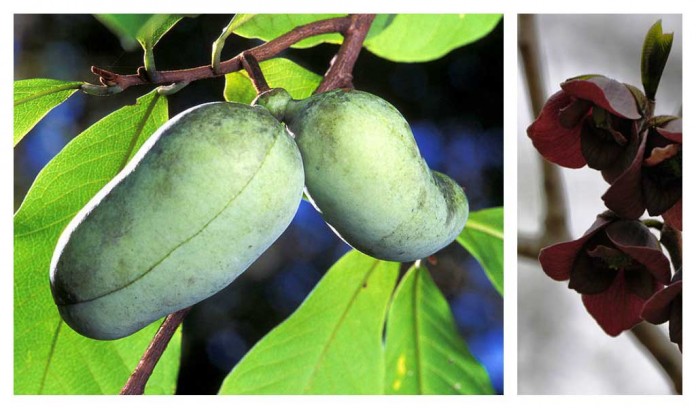Walk through the woods this time of year and you might stumble upon a local delicacy. Behold the pawpaw, a tree that looks like it belongs in the tropics, but is native to the eastern United States.
Wild pawpaw fruit
Pawpaw are the state fruit of Ohio, and common in Ohio’s fertile woodlands. The trees are small, 15-25 feet, and typically grow in groups beneath a canopy of taller trees.
Pawpaw trees produce burgundy purple flowers in spring, followed by clusters of green oblong fruit from late summer through early fall.
Mature fruit darkens and takes on a yellow tint as it ripens in fall. The best way to tell when a pawpaw is ready to pick is giving it a gentle squeeze. Ripe fruit is soft and releases from the tree with ease.
Some say pawpaw look like mangos and taste like bananas, but the fruit has a unique flavor all its own. The peel is bitter and must be removed before consuming. The inner meat is a sweet and creamy custard.
Plant a pawpaw patch
It is difficult to transplant a native pawpaw from the woods because the roots are deep and easily damaged by digging. Experts recommend transplanting grafted trees or container-bound seedlings with compact root systems. Grafted trees produce fruit in 3-4 years. Seedlings in 5-7 years.
Native and cultivated pawpaw trees are available for home growers and commercial producers. Kentucky State University leads an advanced pawpaw breeding program to develop great tasting fruit with a prolonged shelf life (see resources).
More than one cultivar of pawpaw is required for cross-pollination. Pawpaw are pollinated by flies and beetles in nature. Although it is not necessary to hand-pollinate pawpaw, some growers move pollen using a small paintbrush to ensure adequate pollination.
How to harvest and plant wild pawpaw seeds
You can plant seeds from wild fruit, but it takes about 10 years for a seed to grow into a fruit bearing tree.
1. Collect seeds from ripe fruit.
2. Wash free of pulp. Pat dry.
3. Stratify seeds by placing in a sealed bag with peat or sphagnum moss in the refrigerator over the winter. Do not freeze.
4. In spring, prepare containers with potting medium.
5. Plant seeds 1 inch deep.
6. Water regularly.
7. Fertilize with compost or a balanced fertilizer.
8. Keep seedlings protected from wind and intense sunlight.
9. For best results, wait to transplant seedlings until they have several leaves.
How to transplant pawpaw seedlings
1. Choose a place with full sunlight for best fruit production.
2. Gently remove tree from container.
3. Dig a hole slightly larger than the container.
4. Place tree level with ground.
5. Backfill with soil. Tamp down firmly.
6. Water deeply. Provide seedling with regular watering until well established. Create an auto-watering system by poking holes in the bottom of a 5 gallon bucket and then fill with water.
7. Fertilize with compost or balanced fertilizer.
8. Apply mulch.
9. Plant more than one cultivar of pawpaw, at least 15 ft apart and no less than 50 ft apart, to optimize pollination and fruit production. Your pawpaw patch can be a mix of native and cultivated varieties.
Resources
- The Ohio Pawpaw Festival is held at Lake Snowden near Albany, Ohio in September.
- Kentucky State University Pawpaw Program
- Stark Brothers Nursery
- Blossom Nursery













My seeds have sprouted. Some have 4 leaves. When should I plane them in the ground?
The best time to plant paw paw trees is in the spring. However, you can also plant them in the fall. I would try to get them in the ground soon though, so they have time to establish before consistent frosts. You may also want to cover them at night for the first month to protect them from frost while they get established.